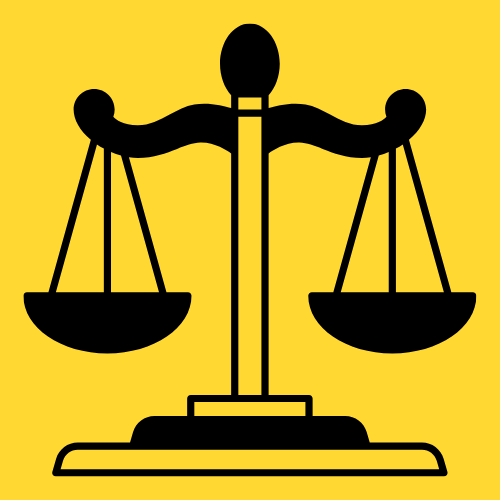A constitution is a system for government that establishes the rules
and principles of an autonomous political entity. In the case of countries,
this term refers specifically to a national constitution defining the
fundamental political principles, and establishing the structure, procedures,
powers and duties of a government. Most national constitutions also guarantee
certain right to the people. The term constitution can be applied to any
overall law that defines the functioning of a government, including several
historical constitutions that existed before the development of modern national
constitutions.[1]
A constitution is an amalgam of constitutional rules and
constitutional principles, which goes under the name of constitutionalism. A
number of constitutional principles are applied to construct a democratic
constitution. Such principles include the Separation of Powers, the Rule of
Law, Independence of Judiciary, Parliamentary Supremacy and Bills of Rights.
The extent to which these principles are reflected in the constitution gives us
an idea of whether or not the constitution is democratic.[2]
The modern constitution may be regarded as the constitution
which established a democratic standard for the separation of powers in
government between the legislature, executive and judiciary.[3]
The doctrine of separation of powers is one of the
basic constitutional principles in the modern constitutions. It refers to the
state power being separated and vested in three organs or branches of the state
to prevent the abuse of power. These are the Legislature, the Executive and the
Judiciary.[4]
This principle of separation of
powers traces its origins at least as far back as Aristotle’s time in his book
titled “Politics, Book IV.[5]
During the age of enlightment, several philosophers such as John Locke
(1632-1704) when philosophing on the theory of social contract in his book “The
Second Treatise on Civil Government” noted the temptations to corruption that exist where
“... the same persons who have the powers of making laws to have also in their
hands the power to execute them ... “., thus he advocated the principle
in his writings, whereas others, such as Thomas Hobbes strongly opposed it.[6]
It was French philosopher, Charles de Montesquieu (1689-1755), who
gave the Doctrine of Separation of Powers its modern famous formulation as a result of visiting England
Charles Montesquieu was concerned with the preservation of political liberty which
was developed in book 11 of “The Spirit of the Laws”. Political liberty is to
be found, he says, when there is no abuse of power. But constant experience
shows that every man invested with power is liable to abuse it, to prevent this
abuse it is necessary from the nature of things that one power should be a
check to another. When the legislative and executive powers are united in the
same person or body, there can be no liberty. Again there is no liberty if the
judicial power is not separated from the legislative and the executive. There
would be an end of everything if the same person or body were to exercise all
power.[7]
Charles
Montesquieu therefore played a very big role in dividing the powers
of the government into the Legislative power, the Executive power in matters
pertaining to the law of nations and the powers of judging which are also known
as the judicial powers. He wrote, “In every state there are three kinds of powers;
the Legislative power, the power executing the matter, falling within the law
of nations, and the power executing the matters which fall within the civil law.
Through the first, the prince or magistrate makes the laws for the time being
of for all time, and amends or repeals those previously made. Through the
second he makes war ad peace, sends and receives ambassadors, establishes
order, prevents invasions. Through the third he punishes crimes and judges the
disputes of private individuals. This last is called judicial power, and the
second is known as the Executive power.[8]
The Doctrine of Separation of Powers by Charles Montesquieu has become an
interesting idea among the constitutional lawyers. As a result, the Doctrine of
Separation of Powers as it has been formulated by Charles Montesquieu underwent
through modifications by way of explanations which have led to the formation of
an existing Doctrine of Separation of Powers in the modern Constitution.
Wade, the
renown English Constitutional Lawyer says that the Doctrine may mean three
different things: the first thing is that the same person should not form part
of more than one of the three organs of government, for example, ministers who
are the members of executive should not sit in parliament; the other one is
that one organ of government should not control or interfere with the exercise
of its function y another organ, for example, the ministers who are the
executives should not be responsible to parliament; also one organ of the
government should not exercise the functions of another organ, for example, the
ministers should not have legislative powers. Wade rightly observes the dangers
of strict application of the Doctrine and so he emphasized upon the checks and
balances which are essential to prevent an abuse of the enormous powers usually
placed in the hands of the executives.[9]
Therefore, all those explanations which were put forward by different
lawyers aimed at making some modifications to the Doctrine as was formulated by
Montesquieu and make it clear as it is appearing in the modern constitution.
However,
Montesquieu was criticized on the ground that his exposition of the Doctrine
was based on the British Constitution of the first part of the 18th
Century as he knew it. Unfortunately his division of power did not exactly fit
the said constitution. The greatest mistake made was his failure to appreciate
the scope of powers of the Executive. To him, executive power meant only the
power executing matters falling within the law of nations, which is, making war
and peace, sending and reception of ambassadors, establishing order and
preventing invasion.[12]
This is not the only mistake. There are many others which he committed
leading to the conclusion that Montesquieu did not make a thorough analysis of
the British Constitution. But, in spite of these criticisms, Montesquieu
succeeded in lying down the foundation for the modern doctrine of the
separation of powers.
The Doctrine of Separation of Powers as was formulated by Charles
Montesquieu is one of the basic constitutional principle which is widely used
in the modern constitutions of several countries. The United States Constitution goes further than any other in
applying the Doctrine. Thus, the federal executive powers are vested in the
president, the federal legislative power is vested in congress and the federal
judicial power is vested in the Supreme Court since, the theory of separation
of powers was said to have influenced James Madison of Virginia, the father of
constitution in the United States of America, who wrote supporting the
incorporation of the Doctrine in the US constitution.[13]
In Tanzania Tanzania
Generally, the
Doctrine of Separation of Powers as was formulated by Charles Montesquieu is
one of the fundamental principles of the modern constitution. The Doctrine
advocates that each organ of the state should be left performing its function,
but the implementation of the idea has been difficult. Hence, there has been
the interference of the theory of Checks and Balances so as to ensure the
proper operation of the Doctrine of Separation of Powers.
BIBLIOGRAPHY
STATUTE
The
Constitution of the United Republic
of Tanzania
BOOKS
I.G.Shivji, (2004) CONSTITUTIONAL
AND LEGAL SYSTEMS OF TANZANIA, Mkuki na Nyota Publishers, Dar-es-salaam
N.Parpworth, (2004) CONSTIUTIONAL AND ADMINISTRATIVE LAW, 3rd Edn, Oxford University
Press, London
P.Jackson and P.Leopold, (2001) CONSTITUTIONAL AND ADMINISTRATIVE LAW,
8th Edn, Sweet and Maxwell Ltd, London
MANUALS
C.K.Mtaki, (1996) CONSTITUTIONS AND LEGAL SYSTEMS OF EAST AFRICA, 1st
Edn, Dar es Salaam , Tanzania
OTHER SOURCES
http://www.textbooksonline.tn.nic.in/Book
Aristotle
http://www.opsi.gvt.uk/revised
statutes/acts/ukpga
[2] I.G.Shivji, Constitutional and Legal Systems of Tanzania, pg 41
[3] http://en.wikipedia.org/wiki/constitution/general-features
[4] Ibid
[6] C.K.Mtaki, Constitutions and Legal Systems of East Africa, pg 191
[7] O.Phillips, Constitutional and Administrative Law, pg 12
[8] C.K.Mtaki, Constitutions and Legal Systems of East Africa, pg 196
[9] Ibid
[10] Ibid
[11] C.K.Mtaki, Constitutions and Legal Systems of East Africa, pg 196
[12] http://www.opsi.gvt.uk/revised
statutes/acts/ukpga
[13] http://www.law.anu/edu/av
[14] CAP 2 R.E 2002
[15] I.G.Shivji, Constitutional and Legal Systems of Tanzania, pg 43


%20(10).png)

%20(700%20x%20300%20px)%20(600%20x%20300%20px)%20(1).gif)


%20(28).png)

0 Comments
PLACE YOUR COMMENT HERE
WARNING: DO NOT USE ABUSIVE LANGUAGE BECAUSE IT IS AGAINST THE LAW.
THE COMMENTS OF OUR READERS IS NOT OUR RESPONSIBILITY.